
Over the past decade, it would have been absurd to suggest that Australia could be a global leader in mitigating climate change and driving a shift to renewable energy. Although there is little doubt that Australia has the environmental conditions to become a major renewable energy power, the country’s politics have been mired in the politicization of climate change and energy policy, wasting both critical time and economic opportunity.
This has also proved a massive own goal with its broader strategic goals in its immediate region. Australia’s climate recalcitrance has often strained relationships with its Pacific neighbors, which understand climate change to be their primary security threat, and deem it essential that any power within the Pacific Islands Forum shared their position.
However, the change of government in Australia in May has created a noticeable shift in Canberra’s attitude. Given that the Australian public made climate change one of the key themes of May’s election, Labor has clearly understood there was a pressing need to draw a line under Australia’s “lost decade.” In early September the parliament passed significant climate change legislation that pledged to reduce Australia’s carbon emissions by 43 percent by 2030 and move to net zero emission by 2050. The new legislation will now give Australia’s energy sector the certainty necessary to shift itself toward cleaner energy, after years of policy confusion.
To explain Australia’s new shift in policy and posture, Minister for Climate Change and Energy Chris Bowen has been in the United States this past week. Bowen initially attended the Global Clean Energy Forum in Pittsburgh, and subsequently delivered a speech to the Center for Strategic and International Studies, which outlined Australia’s plans for its energy transition, and how Canberra now seeks to play a leading diplomatic role in the global effort to cut humanity’s carbon emissions.
Bowen framed his speech by shifting the language on the world’s timeline to create a significant energy shift. Rather than the seemingly distant 2030, Bowen pointed out that this is just 87 months away, and that there are a number of urgencies that need to be addressed with regard to infrastructure to create a renewables-led future. Bowen highlighted current supply chain vulnerabilities, with around 80 percent of solar panels being manufactured in China, as well as China dominating the market in lithium-ion batteries used for both energy storage and electric vehicles. Bowen said it was in the interests of both Australia and the U.S. to develop greater renewable manufacturing capabilities, with the two countries providing more reliable supply chains for each other.
The key strategic problem for Australia is transforming itself from its current position of simply mining critical minerals used in renewable technology into a manufacturing power. Bowen mentioned the problem but offered no pathways to achieving the greater goal. Australia’s current Critical Minerals Strategy has sought to develop greater local capabilities to process critical minerals but lacks the ambition to see Australia as more than just a supplier of materials to the advanced manufacturing capabilities in Japan and South Korea.
Russia’s invasion of Ukraine highlighted problems with the world’s reliance on energy from nefarious states like Russia or even states with poor human rights records like Saudi Arabia. Bowen noted that “renewable energy has in-built security advantages” with both sunlight and wind being unaffected by geopolitical disruptions or calculations. Here Bowen was echoing German Finance Minister Christian Lindner who upon Russia’s invasion of Ukraine stated that renewables were “the energy of freedom.”
The important questions now for Australia are whether it is capable of making the necessary investments to achieve this freedom, and does the country have the credibility to play a leading role in global climate change mitigation diplomacy.
A recent report from the Australian Academy of Technological Sciences and Engineering indicates that the country is on track to generate half its domestic energy needs from renewable sources by 2025, with Bowen stating that the government’s objective is to expand this to 82 percent by 2030.
This is a positive trajectory, but it is not solely the sources of its domestic energy consumption that Australia needs to shift, as the country has a massive fossil fuel export industry that should be considered part of its emissions, even if it doesn’t burn the fuel itself. While Australia’s domestic energy consumption currently accounts for around 1.1 percent of global emissions, when taking into account the predominantly coal and gas Australia exports, the country’s footprint expands to around 5 percent of global emissions. Given that Australia’s population is only 0.33 percent of the global total, this makes Australia a major per capita emitter.
Australia clearly has a great responsibility to be part of the global solution to climate change. The new Australian government looks to be recognizing this, and this is something that will be welcomed by its neighbors in the Pacific. Yet these Pacific neighbors will also be keeping a keen eye on Australia’s actions, to see whether this shift in rhetoric is also accompanied by a serious shift in behavior.
Australia’s Budding Climate Change Reversal
Source: Frappler

0 Comments